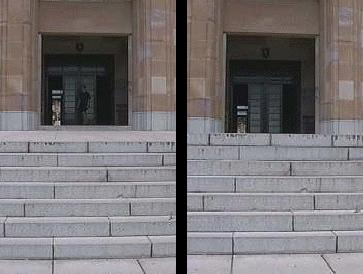|
Successful interactions between an observer
and the environment, and objects within the environment, implies
an knowledge of what actions are possible and appropriate in
any given situation. Gibson (1979) defined affordances
as the opportunities for action for the observer provided by
an environment, and proposed that observers perceive these affordances
rather than abstract physical properties of objects and environments.
In this sense affordances are real. They have
a relational ontology in they do not exist as a function of either
the environment or the observer alone, but only have existence
in the interaction between the physical capabilities and properties
of the observer and the physical properties of the environment.
For example a stair case of certain dimension may afford bipedal
locomotion by an adult, quadrupedal locomotion by an infant,
and a barrier to an observer confined to a wheelchair.
Affordances are likely to be both dichotomous
at critical points that correspond to transitions for behaviour,
and possess a preferred range corresponding to best fit between
environment and observers capabilities and characteristics. For
example, Warren (1994) demonstrated that
a critical ratio of riser height to leg length determined whether
a stair was climbable bipedally or not, and that a different
ratio corresponded to the most metabolic efficient riser height.
Further, observers were able to correctly distinguish climbable
and non-climbable stairs, as well as the metabolically optimal
riser height, from visual information. The perception of affordances
is likely to involve body-scaled metric rather than arbitary
metric, and it seems likely that eye height information is utilised
in the perception of affordances.

The same stair case viewed from different eye heights. Which
stair case looks harder to climb?
As we have seen in previous sections, the
optic array specifies relationships among layout of surfaces,
and the relationship of those surfaces to observer. The optic
array also provides information about self, including motion
of head/body and hands. While knowledge about an affordance such
as the climbability of a staircase could be determined through
a process of perceiving the height of the riser and comparing
this with a memory of the height of stairs which the observer
is capable of climbing, Gibson proposed that, in the same way
as local disturbances in the optic flow provided information
about events, higher order optical invariants provide information
about affordances.
For affordances to be perceived observers
must be sensitive to the information in the optic array; and
attend to that information. Attention is directed by intention,
so that, for example, a rock forming part of the supporting surface
may be ignored during locomotion, but attended to when a hammering
tool is required. Perception of affordances is influenced by
experiences, and can be learned.
Tools have dual functions tools as objects
contribute to the affordance of the environment. Before being
used, a tool has its own affordances, inviting certain actions.
Tools in use are no longer just objects, now they extend the
persons capabilites (effectivities) and become components of
the effectivity system. In complex situations affordances may
be nested. For example, a macadamia nut affords cracking and
eating, but only if an appropriate object which affords cracking
the nut can first be located.
Affordances are sometimes misperceived. The
baby approaching, but not crossing, the visual cliff (Gibson
& Walk, 1960) has misperceived the
affordance of the glass surface; and similarly, a pedestrian
who walks into a glass door has made a similar error. Such errors
are uncommon in the natural environment, but more common in fabricated
environments and objects. Indeed, the general challenge for designers
is to design environments and objects so that the affordances
are accurately and easily perceived with minimum learning.
Implications for design
The designer's task is more difficult than
an observer's. The designer must perceive the affordances of
a situation for others. The designer's task is often underestimated
because people are so proficient at judging affordances for themselves
that they fail to recognise the inherent difficulties in accurately
assessing the affordances for others.
The task is similar to that of an adult assessing
the affordances of an environment for a child in their care.
People are less accurate at perceiving the capabilities of others.
For example Zaff (1995) found that people
underestimated the height to which people shorter than them could
reach, but overestimated the height that taller people could
reach. The exception were experienced child care workers who
overestimated slightly the height to which shorter people could
reach, explaining "Little children can always reach higher
than it looks like they can".
Design is a process which requires simultaneously
taking into account the structural and dynamic properties of
individuals who will be using the product and the structural
and dynamic properties of the product.
The use of natural mappings between actions, and consequences
of actions, is likely to increases the ease of perception of
affordances.
The use of metaphors is a common design tactic
to convey information about affordances, but not always an effective
tactic. The necessity for the use of signs to indicate appropriate
action indicates a design in which the affordance is not easily
perceived, or in some cases where the affordances perceived is
not the action the designer intended. (see This
is a Mop Sink).
Required Reading
Gibson, 1979
Warren 1995
Norman, 1998
|
